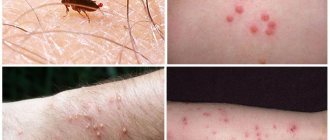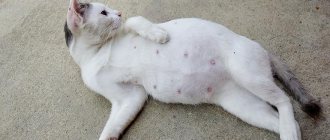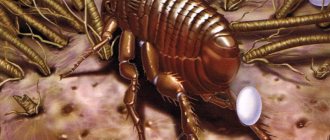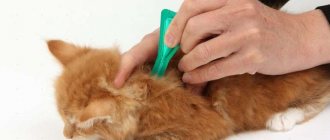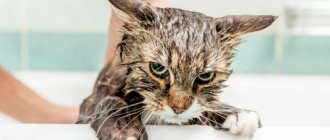What do fleas look like on cats?
Fleas are wingless brown insects with 3 pairs of legs, the last of which is better developed than the others and is used for pushing off the surface when jumping, the length of which can reach 1.5 meters. Their body is flattened laterally, its length is 2–2.5 mm.
The flea has a laterally flattened body and three pairs of legs; no wings
The flea is protected from external influences by a chitinous shell, on which there are multiple spines and outgrowths that help it stay on the surface of the skin and fur. The parasite has a piercing-sucking type of mouthparts.
The flea lives for about 2 years, and actively reproduces. Fleas lay eggs wherever they can, and the worm-like larvae that emerge from the eggs feed on dust, debris, and various contaminants. The larvae turn into pupae, which, under unfavorable external conditions, can remain viable in the external environment for up to 1 year. The entire development cycle of a flea under favorable conditions takes only 2–3 weeks.
Fleas are highly mobile and tend to change hosts. It is extremely important that the majority of fleas live in the room where the cat is kept, while on the cat itself the number of parasites does not exceed 5–10% of the existing number.
Fleas are carriers of diseases:
- hemobartonellosis - infectious anemia of cats;
- tularemia - a natural focal infectious disease;
- helminthic infestations: dipilidia - parasitism of cucumber tapeworm;
- dipetalonematosis - parasitism of small roundworms - microfilariae. The disease occurs in Africa, South America, and southern Asia.
Ways of flea infection
Flea infestation occurs when:
- direct contact with infected relatives;
- through bedding, toys, and care items infested with fleas, their eggs and larvae;
- fleas can live in an apartment, periodically attacking a cat;
- A mother cat with fleas infects her kittens with them immediately after their birth.
If a mother cat has fleas, all her kittens become infected.
Effective ways to get rid of fleas
Fighting fleas is difficult due to their biological and physiological characteristics. They reproduce quickly, turning from larvae to adults in two weeks. The lifespan of one individual reaches two years. During this period, the female manages to lay several hundred eggs. If fleas are not detected at the initial stage of their appearance, the scale of the disaster will become catastrophic. It will take a lot of time and effort to destroy a large population. They cannot be attracted by food bait, like other insects, since fleas are only interested in blood.
Depending on the number of fleas in the apartment and the neglect of the situation, different control methods will help get rid of ectoparasites. In the initial stages, you can solve the problem yourself. But if the parasites have already managed to multiply, then effective ways to get rid of fleas will include an integrated approach and professional help from pest control services.
Independent options for killing fleas
The greatest effectiveness in self-extermination of fleas comes from an integrated approach, which involves the use of traditional, physical and chemical control methods. Let's take a closer look at each of the options.
Chemicals against fleas
In the store you can find insecticidal preparations in the form of aerosols, liquids, powders, gels, and granules. The release form greatly influences the effectiveness of the chemical.
The maximum result is obtained by preparations in the form of aerosols, since the working solution is sprayed into them in the form of a mixture of tiny particles and air. This allows the insecticide to penetrate into all joints, cracks and openings. Spraying is a quick and effective way to treat large areas of the apartment. Among aerosols, Raptor, Get, Dichlorvos, and Reid show good results.
When using aerosol insecticides, the apartment will need to be left for some time - several hours or days (depending on the recommendation in the instructions). At this time, there should be no animals or people in it.
Dusts - powder preparations - are actively used to combat fleas. The process of treating an apartment will be more labor-intensive and expensive, but it is suitable for pet owners. Dust must be scattered under carpets, along cracks, under baseboards. It can be left for a long time until all the fleas are killed.
Before purchasing an insecticidal product, study its effectiveness and analyze user reviews. The product should be used strictly in accordance with the instructions, observing all safety rules:
- prepare the working solution in a well-ventilated area;
- Before using the insecticide, put on gloves, a respirator, and safety glasses;
- strictly adhere to dosages;
- close all doors and windows while spraying;
- leave the insecticidal preparation after spraying in the apartment for the time specified in the instructions;
- at the last stage, carry out a thorough wet cleaning to remove residual pesticides and ventilate the apartment.
After the first treatment, repeated disinsection is often required, since the shell of flea eggs is highly resistant to the action of chemical components.
Traditional methods of repelling fleas
Traditional methods of control are not able to cope with a large population of fleas. They will be useful for scaring away individual individuals and will help prevent the reappearance of insects in the home. Most folk methods of fighting fleas are based on the use of substances, plants and mixtures with a pungent odor. These can be herbs, household preparations, chemical components, vegetables, fruits:
- fresh and dry bunches of tansy, mint, wormwood and eucalyptus;
- fresh garlic cloves;
- solution with soda and salt;
- lemon and orange zest;
- ammonia.
To protect your home from fleas, fragrant bunches of plants can be placed in rooms, in closets, near beds.
If it is not possible to use herbs, they can be successfully replaced with essential oils or concentrated tinctures. Scented solutions can be applied to all surfaces using a rag or a spray bottle. A solution of soda and salt must be left for at least 12 hours before use. After this, it is applied to toys, carpets, upholstered furniture and other textile surfaces and left for several hours. Upon completion of processing, the mixture is removed with a vacuum cleaner. It should be noted that soda and salt are not able to destroy flea eggs.
Other ways to control fleas yourself
Modern manufacturers and popular ingenuity offer several more options for killing fleas:
- Electronic ultrasonic repeller. The developers indicate that the action of the device is based on the generation of waves that irritate the nerve endings of parasites. Fleas are in a hurry to leave the room. The effectiveness of this method has not yet been proven and is highly questionable.
- Disinfection with kerosene. The method is only applicable if residents will be able to leave the apartment for several days. Kerosene is a chemical substance that negatively affects human and animal health.
- Fleas and larvae on textile items can be combated using extreme temperatures: use an iron or steamer, take things out onto the balcony for several days in winter, wash clothes in hot water. This method will not destroy flea eggs.
Only an integrated approach will allow you to independently remove fleas from your apartment. The owner of a residential premises must determine and eliminate the cause of the appearance of ectoparasites, treat the house from adults, larvae and eggs, and organize a protective barrier that will prevent the insects from reproducing.
Professional pest control
The only way to be sure to get rid of fleas in your apartment is to seek help from a professional insect extermination company. If you decide to treat your apartment for fleas, you should warn your neighbors. They may also schedule pest control at that time. This will prevent the migration of parasites to other apartments.
To combat parasites, specialists use proven, certified insecticidal preparations with proven effectiveness, which do not leave a persistent odor or marks on walls, flooring, or furniture upholstery.
To treat the room, special equipment is used - a hot or cold fog generator. This is a device that sprays a working solution in the form of an aerosol, that is, a mixture of air and tiny chemical particles. Sometimes the drug is preheated. The insecticide hovers in the air for some time, gradually sticks to all surfaces, and penetrates into all cracks and joints. The effect is further enhanced by the prolonged action of the chemical, which continues to have a detrimental effect on parasites after treatment for several more weeks.
Causes of flea dermatitis in cats
Flea dermatitis is an inflammatory skin disease of allergic origin. It is based on the formation of hypersensitivity to flea bites, the saliva of which is a complex allergen. There are:
- Immediate hypersensitivity reactions occur when an allergen to which an antibody titer has already been developed is re-entered into the body. The meeting of the allergen and antibody occurs on the membrane of mast cells and causes the release of a large amount of biologically active substances (histamine, bradykinin, serotonin, heparin, reactive oxygen species). This type of reaction for flea dermatitis is manifested by the occurrence of: redness of the skin;
- skin itching;
- urticaria (the appearance of skin infiltrates accompanied by itching and redness of the skin). In some cases, these signs appear immediately after the very first flea bite, and we are talking about atopy - an altered type of immune system response that is inherited.
Flea dermatitis, fortunately, does not affect all cats that have been bitten by fleas, since flea bites do not cause an allergic restructuring of the immune system in all pets. Most often, with flea dermatitis in cats, delayed-type hypersensitivity reactions or a mixed type of reaction develop. The disease of flea dermatitis, as well as its exacerbations, is characterized by seasonality. When fleas live indoors, there is no seasonality of the disease in cats.
Video: flea dermatitis
Symptoms of flea bites
These bloodsuckers live in any house, but prefer to live on the first and last floors. They are also attracted to homes with animals.
Fleas are very small and it is almost impossible to see them. But it’s not at all difficult to guess that fleas have bitten a child. A swollen red bump with a radius of about 10 mm appears at the site of the bite. Subcutaneous hemorrhage is observed in the same place. The child begins to itch intensely, causing the bites to become huge. Microbes accumulate on the baby’s hands, which he spreads throughout the body and infects other areas of the skin. The effects of flea bites last up to 5 days.
You can be completely sure that it was fleas and not other insects that appeared on the baby’s body only after an additional and thorough examination of the bites.
What do flea bites look like on a child’s body:
- These are multiple wounds. Around each of them there are several short paths with additional markings. Fleas are jumping insects, so they do not hide their actions. At any moment they can bite and jump to another area. This explains the fact that the marks are located on the same track in different places.
- Do not confuse flea bites with bedbug punctures, which leave behind similar stains and blood on the sheets.
- When bitten, the child feels severe pain, since the insect’s saliva does not contain painkillers.
- Any flea attack ends with the appearance of a red spot with a characteristic puncture inside it. After a while, the skin under the spot thickens and a papule appears, and a rash appears at the site of the bite.
Every parent should know what flea bites look like on children and how they differ from other irritations. This will help you quickly understand the situation and take effective measures.
Main manifestations of flea dermatitis in cats
The most common manifestations of flea dermatitis in cats are:
- miliary dermatitis - redness and multiple blisters (vesicles) appear on the skin, which, when opened, form small erosions. After the erosions dry out, numerous crusts appear. With a long course of the disease, the affected areas acquire a dark color - acanthosis nigricans develops. The fur thins and falls out. The disease is accompanied by unbearable skin itching; when scratching, infection occurs with secondary microbial flora;
- formation of foci of baldness in the absence of inflammatory manifestations;
- development of the eosinophilic granuloma complex - accumulations of eosinophils and lymphocytes in the lesions take part in the development of all its forms. Manifestations: eosinophilic granuloma - looks like: whitish nodules or tubercles on the oral mucosa;
- linear intradermal thickenings on the body.
- nausea;
- deterioration of the cat’s general condition;
- irritability;
Photo gallery: manifestations of flea dermatitis in cats
baldness is a characteristic sign of flea dermatitis
eosinophilic granulomas look like intradermal thickenings in the shape of a line; eosinophilic plaques can merge to form continuous eroded surfaces
acute dermatitis caused by an allergy to flea bites; miliary dermatitis is represented by small erosions and crusts on the skin
Diagnosis of flea dermatitis
The diagnosis is made based on:
- detection of typical skin manifestations with signs of flea infestation (the presence of fleas or their excrement on the cat’s skin);
- studying scrapings from a cat's skin;
- histological examination of a skin sample - in some cases, to clarify the nature of the disease;
- general blood test - an increase in the content of eosinophils is typical; when allergic dermatitis is complicated by secondary microbial flora, leukocytosis will appear; when infected from fleas with hemobartonellosis or helminths, hemoglobin will decrease;
- skin allergy tests - are necessary in cases where signs of flea parasitism are not visually determined in a cat. Fleas can bite a cat periodically, without parasitizing on it and living in the external environment;
- the presence of positive dynamics in the course of the disease after the use of drugs that destroy fleas.
A cat owner can suspect the presence of flea dermatitis on his own, but examination by a veterinarian is necessary, since there are diseases that have similar symptoms:
- mite damage: sarcoptic mange;
- notoedrosis;
- demodicosis
When a cat is infested with fleas, dark flea excrement is detected in the cat's fur.
Allergy in children to flea bites
Flea bites do not go away without leaving a trace. And it's not just pimples and scabies. Other symptoms may also occur, such as:
- temperature rise to 38°;
- intestinal disorder;
- lymphadenitis;
- nervousness;
- rarely anaphylactic shock;
- itching, pain;
- allergic reactions.
The appearance of allergies is a possible phenomenon. Fleas really like the delicate skin of babies, which lends itself well to the pressure of insects, and supplies them with a valuable product - their blood.
In addition, fleas bite a child, and thereby spray an enzyme into his body that interferes with blood clotting. And if there are a lot of fleas, then there will be an increased amount of enzyme, which will provoke the appearance of a life-threatening rash. In childhood, the immune system is not developed enough to withstand such a problem.
In 50% of cases, the rash can cause angioedema, which in some cases has unpredictable consequences. Facial swelling is directly related to swelling of the laryngeal mucosa and the membranes of the brain. The danger lies in squeezing the blood vessels, which can lead to asphyxia. The appearance of neurological disorders, including epilepsy and its accompanying manifestations, is possible.
Treatment of flea dermatitis in cats
For the treatment of flea dermatitis, the following are used:
- Corticosteroids - in order to suppress the reaction of allergic inflammation, they are effective in 90% of cases of systemic use: Prednisolone;
- Dexamethasone;
- Hydrocortisone.
- Tavegil;
- Sinulox;
- Stronghold;
- Advantage - both effectively destroys and repels parasites, this is a rare combination of properties;
- calcium chloride;
- Feliderm;
- Rolf Club;
- Levomekol ointment;
Photo gallery: drugs for the treatment of flea dermatitis
Prednisolone quickly relieves skin itching and reduces inflammation in flea dermatitis
Tsiprovet is prescribed for a short course of 5 days in the presence of bacterial complications
Tavegil suppresses the release of histamine from mast cells in immediate allergic reactions
The uniqueness of Advantage lies in the combination of insecticidal and repellent effects
Stronghold effectively destroys fleas at all phases of their development
Table: products used for external flea treatment
| A drug | Compound | Operating principle | Price, rub |
| Stronghold, drops on the withers | Selamectin | Destroys eggs, larvae and adult forms of external parasites, as well as roundworms. Apply once a month. Possible during pregnancy and nursing kittens. Not allowed for kittens under 6 weeks of age. | 386 |
| Frontline Spray | Fipronil | Destroys external parasites and ixodid ticks. Protects against fleas for up to 40 days. You should not bathe 2 days before using the spray, or 2 days after. Suitable for pregnant and lactating cats, as well as kittens from 2 days of age | 881 for 100 ml |
| Leopard, drops on the withers |
| Destroys external parasites and ixodid ticks. Protects against fleas for up to 1–2 months. Cannot be used during pregnancy, lactation, or in kittens under 8 weeks | 176 |
| Green Fort | Citronella essential oil | Repels fleas and other external parasites. Can be used in pregnant and lactating cats, and in kittens from 4 weeks of age. Highly safe product | 375 |
Means used internally
Flea control agents used internally:
- Comfortis tablets - the active ingredient is spinosad, which causes paralysis and death of fleas. The effect begins within half an hour after taking the tablet and lasts for 1 month. Not applicable during: pregnancy;
- lactation;
- under 14 weeks of age in kittens;
- epilepsy;
- individual hypersensitivity to the components of the product.
Traditional medicine
For flea dermatitis, the use of folk remedies is possible, but it is better to do this in combination with veterinary remedies to destroy skin parasites, as well as taking medications prescribed by a veterinarian. Folk remedies will improve the condition of the skin and coat and help get rid of some parasites, but it will not be possible to cure flea dermatitis using only folk remedies.
Traditional methods include bathing your pet in herbal infusions:
- capable of destroying a small number of parasites: wormwood;
- tansy.
- calendula;
Infusions for bathing are prepared:
- Take 100 g of dry herb.
- Add 2 liters of boiling water.
- Leave for 30 minutes in a water bath.
- Leave for 1 hour after removing from the water bath.
- Strain the infusion.
- Add water to the required volume for bathing.
To repel parasites, you can use a bag of dried wormwood or tansy grass, tied to the cat's collar.
Photo gallery: traditional medicine for the treatment of flea dermatitis:
You can wash your cat with tansy infusion to reduce the number of parasites
dry wormwood in a bag attached to a cat's collar can repel fleas
calendula infusion has a disinfecting effect on skin lesions and also reduces inflammation
Features when treating pregnant cats and kittens
The development of flea dermatitis in pregnant cats is very dangerous, since the severe disease requires the use of corticosteroids and antibiotics, which are contraindicated during pregnancy. In small kittens, flea dermatitis occurs extremely rarely before the age of 6 months, is represented by immediate reactions and usually indicates existing atopy, the extreme manifestation of which can be anaphylactic shock, which poses a direct threat to the life of the kitten. It is important to prevent flea attacks on pregnant cats and small kittens; if there is a flea infestation, it is necessary to treat the mother cat and babies with Frontline spray, which is approved for use in pregnant and lactating cats, as well as in kittens from 2 days of age.
Destruction of fleas with the help of specialists
This method is the simplest, most reliable and convenient. Specialists will quickly treat your home from annoying fleas and provide a guarantee for the treatment. In addition, the poisons used by pest control services are safe for people and animals. The products used undergo mandatory certification, for which there are the necessary documents. But this method cannot be called cheap. The services of disinfectants will cost you a pretty penny, but will save you from lengthy and possibly futile attempts to remove fleas yourself. The equipment used by professionals is designed specifically for the destruction of parasites, and its high cost is justified by the same effectiveness.
It doesn't matter which method you use to get fleas out of your home. It is important to prevent their reappearance. Seal all cracks in the floor, check the animals periodically and carry out wet cleaning as often as possible. It would be useful to additionally treat the basement against rodents. Perhaps they became the primary cause of fleas in the house.
How to rid your cat of fleas and prevent their appearance
It is necessary to act on fleas in a comprehensive manner, since fleas at different stages of development and in large quantities are kept in the room where an infected cat lives:
- All domestic animals with fur are subjected to simultaneous treatment for external parasites;
- in the future, animal protection is achieved by regular preventive use of insecticides, as well as repellents in any forms convenient for the owner for all pets;
- regular repeated wet cleaning of the floor and horizontal surfaces is carried out using solutions of Neostomozan or Ecocide;
- upholstered furniture, carpets, car interiors, cat beds are regularly vacuumed, reliably getting rid of the contents of the vacuum cleaner (it is better to burn), and you can also use a steam generator;
- prevent contact between pets and stray animals;
- Wash your hands thoroughly after contact with other people's pets to prevent the transfer of parasites to your cat.
Regular flea treatment with veterinary insecticides is used both for the treatment of flea dermatitis and for its prevention
Flea prevention
After exterminating fleas, it is important to prevent their reappearance. To do this, it is enough to follow simple rules. Preventing your apartment from fleas involves regular inspection and proper care of pets, keeping the house clean, and using natural and artificial repellents.
If your work activity involves being in a basement or other places with a warm and humid microclimate, you must leave your work clothes in the work closet. After leaving a room where fleas may live, you should inspect yourself for the presence of ectoparasites.
Separate recommendations should be given to owners of pet four-legged friends. To help prevent fleas:
- Regular treatment of animals with special sprays and drops.
- Using a flea collar.
- Regular washing of cat and dog beds, clothes and other textile items.
- Using anti-flea shampoo.
- Inspect your pet after every walk.
- Regular combing with a special comb.
Residents of the first floors of apartment buildings are most likely to become victims of fleas.
It is to them that ectoparasites often migrate from the basement through the ventilation system. A protective barrier using repellent scents and chemicals will help reduce the risk of insects. Particular attention to this issue should be paid in the summer - during the mass reproduction of ectoparasites. If you want to guarantee and quickly get rid of fleas in your apartment, contact the professional pest control service “Des Group” for help. Specialists will thoroughly treat the room using a fog generator and an effective long-acting insecticide. To prevent recurrence, the team will organize a protective barrier and give recommendations on preventive measures. To clarify the cost, free consultation and fill out an application, fill out the form on the website or contact the Dez Group manager by phone.
Calculator
Calculate the cost of exterminating insects in the house
Number of rooms:
(Cold fog)
(Cold Fog + Barrier Defense)
(Hot fog + Premium drugs + Barrier protection)
(Hot fog + VIP drugs + Barrier protection)
Total cost: 01
Order processing
